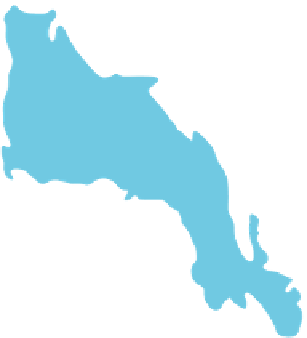Environmental Engineering Reference
In-Depth Information
19.2.2.1 Prairie Potholes
Prairie potholes, often also called “sloughs,” are most common in the Great Plains of North
America, and, in particular, the Upper Midwest (e.g., North Dakota, South Dakota, Wisconsin,
Iowa, and Minnesota; Figure 19.4). They were primarily formed by glaciation and the subsequent
melting of buried blocks of ice, leaving a great number of shallow depressions, often round like a
“pot,” which formed these wetlands. The water sources are primarily either direct precipitation or
snowmelt. Some prairie pothole marshes are ephemeral or temporary, while others are seasonal or
semipermanent. Often, the ephemeral wetlands are not wet long enough to support hydric vegeta-
tion (Stewart and Kantrud 1969). While some are large, most prairie potholes are less than 1 acre
in size. Although these wetlands are small, they are at least historically common. They provide a
variety of ecological services but are most often noted for their importance to migratory waterfowl.
19.2.2.2 Playas
Playa lakes are similar to prairie potholes in that they are usually shallow, round depressions in
semiarid regions such as in West Texas, Oklahoma, New Mexico, Colorado, and Kansas. Unlike
potholes, playa lakes are most commonly formed by wind action rather than glaciation, or, in
some cases, by dissolution or land subsidence. As with some potholes, they are ephemeral, char-
acterized by short, infrequent, and unpredictable water availability, and are usually shallow with
sparse vegetation. Some playa lakes are “wet” only once every few years and then often for short
periods of time. Historically, playas have served as the main water source on the plains, such as
for American Indians and nineteenth-century settlers (Graves 2006). These wetlands are also
extremely important to waterfowl. But since they are only periodically and often infrequently
“wet,” waterfowl often rely on a large network of playas, selecting those that are suficiently wet
(Robinson and Oring 1996; Robinson and Warnock 1996) rather than single or speciic wetlands.
Comanche, and later hide hunters, knew that bison drank from the playas and often hunted them
at water holes.
Alberta
Saskatchewan
Manitoba
Canada
United States
Minnesota
North
Dakota
Montana
South
Dakota
Iowa
FIGURE 19.4
Prairie pothole regions of North America. (From Euliss, Jr. N.H., Mushet, D.M., and
Wrubleski, D.A., In: D.P. Batzer, R.B. Rader, and S.A. Wissinger (eds),
Invertebrates in Freshwater Wetlands
of North America: Ecology and Management
, John Wiley & Sons, New York, p. 471, 1999.)


Search WWH ::

Custom Search